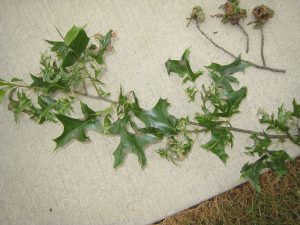
Leaf galls on oak trees?
Photo Credit: M&L Wagner, Indianapolis
Q. We have a pin oak tree that is approximately 30 feet tall. On the north-facing side of the tree there are many wilted leaves, and there are many balls of strange growth. Pictures of the leaves and the balls are attached. Can you help to identify the problem and any solutions that we need to pursue? – M&L W, Indianapolis
A. My best guess is one of the many leaf galls common to oak trees. Leaf galls are usually more of a cosmetic problem rather than a health crisis and do not warrant chemical control. The gall itself is primarily made up of plant tissue that forms when insects lay eggs inside the leaf tissue and either the adult or the developing young insects secrete a growth-stimulating substance. Each insect causes a very characteristic gall. Most leaf galls are nothing to be concerned about from a plant health standpoint, although they may be unsightly. However, once the gall appears, the appearance of the current growth cannot be remedied. Some of the most common landscape plants that develop galls include oaks, maples, hackberries and roses. More information regarding galls on trees available in Purdue Extension publication E-56 at http://extension.entm.purdue.edu/publications/E-56.pdf.
Wilting could be a more serious problem at work that we cannot identify from the photos. I encourage you to send samples of your oak tree to the Purdue Plant and Pest Diagnostic Laboratory for diagnosis. More information about submitting a sample can be found at www.ppdl.purdue.edu/ppdl.
Q . I have had problems growing tomatoes for the past three years. The branches start turning yellow then brown and then die. By the end of the growing season only a few green leaves are left at the top of the plant. I have rotated the planting areas, sprayed for fungus and have amended the soil to no avail. A few other people I know have experienced the same problem. Any suggestions for how to deal with this would be appreciated. – JB, Valparaiso, Indiana.
A. Since you’ve had the problem for several years, I recommend that you send a plant sample in to the Purdue Plant and Pest Diagnostic Laboratory this year as soon as the symptoms appear. Once the problem is identified, a strategy for prevention can be implemented, but it is hard to be specific unless the cause is confirmed. More information about submitting a sample can be found at www.ppdl.purdue.edu/ppdl.
Meanwhile, there are a number of management practices that can help reduce the occurrence of fungal diseases. Crop rotation would help, but, in a small garden, this would mean only planting tomatoes once in three or four years. Most gardeners won’t be willing to forgo their beloved tomatoes that long!
Good garden sanitation can help reduce the carryover of disease from year to year. Remove badly diseased leaves as soon as the spots are detected and rouge out badly infected plants ASAP. Keep the foliage of the plants as dry as possible. Allow plenty of space between plants for good air circulation. Avoid watering with overhead sprinklers in late afternoon or evening. Plants that stay wet all night provide the perfect conditions for fungal spores to infect. Use trickle or drip irrigation where feasible. Remove and destroy all tomato plants after killing frost.
Q. I was digging up dandelions in my asparagus patch and they were pretty big. On the roots I saw lots of tiny white “eggs.” Can you identify what they were and whether they are good or bad? I did some searching on the Internet but could not come up with an answer. – MF, Scipio, Indiana
A. We would need to see a sample to be able to confirm, but I suspect root knot nematodes as the culprit. Root knot nematodes cause “egg-shaped” structures on roots of dandelion and many common garden plants, but, fortunately for you, asparagus is resistant. More information about nematodes can be found athttp://extension.entm.purdue.edu/nematology/melonnems.html and in Purdue publication E-79http://extension.entm.purdue.edu/publications/E-79.pdf.